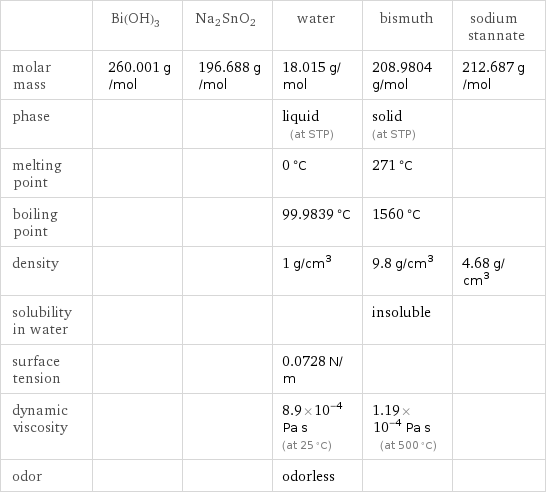Input interpretation

Bi(OH)3 + Na2SnO2 ⟶ water + bismuth + sodium stannate
Balanced equation

Balance the chemical equation algebraically: Bi(OH)3 + Na2SnO2 ⟶ + + Add stoichiometric coefficients, c_i, to the reactants and products: c_1 Bi(OH)3 + c_2 Na2SnO2 ⟶ c_3 + c_4 + c_5 Set the number of atoms in the reactants equal to the number of atoms in the products for Bi, O, H, Na and Sn: Bi: | c_1 = c_4 O: | 3 c_1 + 2 c_2 = c_3 + 3 c_5 H: | 3 c_1 = 2 c_3 Na: | 2 c_2 = 2 c_5 Sn: | c_2 = c_5 Since the coefficients are relative quantities and underdetermined, choose a coefficient to set arbitrarily. To keep the coefficients small, the arbitrary value is ordinarily one. For instance, set c_1 = 1 and solve the system of equations for the remaining coefficients: c_1 = 1 c_2 = 3/2 c_3 = 3/2 c_4 = 1 c_5 = 3/2 Multiply by the least common denominator, 2, to eliminate fractional coefficients: c_1 = 2 c_2 = 3 c_3 = 3 c_4 = 2 c_5 = 3 Substitute the coefficients into the chemical reaction to obtain the balanced equation: Answer: | | 2 Bi(OH)3 + 3 Na2SnO2 ⟶ 3 + 2 + 3
Structures

Bi(OH)3 + Na2SnO2 ⟶ + +
Names

Bi(OH)3 + Na2SnO2 ⟶ water + bismuth + sodium stannate
Chemical names and formulas

| Bi(OH)3 | Na2SnO2 | water | bismuth | sodium stannate formula | Bi(OH)3 | Na2SnO2 | | | Hill formula | H3BiO3 | Na2O2Sn | H_2O | Bi | Na_2O_3Sn name | | | water | bismuth | sodium stannate IUPAC name | | | water | bismuth | disodium dioxido-oxo-tin
Substance properties

| Bi(OH)3 | Na2SnO2 | water | bismuth | sodium stannate molar mass | 260.001 g/mol | 196.688 g/mol | 18.015 g/mol | 208.9804 g/mol | 212.687 g/mol phase | | | liquid (at STP) | solid (at STP) | melting point | | | 0 °C | 271 °C | boiling point | | | 99.9839 °C | 1560 °C | density | | | 1 g/cm^3 | 9.8 g/cm^3 | 4.68 g/cm^3 solubility in water | | | | insoluble | surface tension | | | 0.0728 N/m | | dynamic viscosity | | | 8.9×10^-4 Pa s (at 25 °C) | 1.19×10^-4 Pa s (at 500 °C) | odor | | | odorless | |
Units
